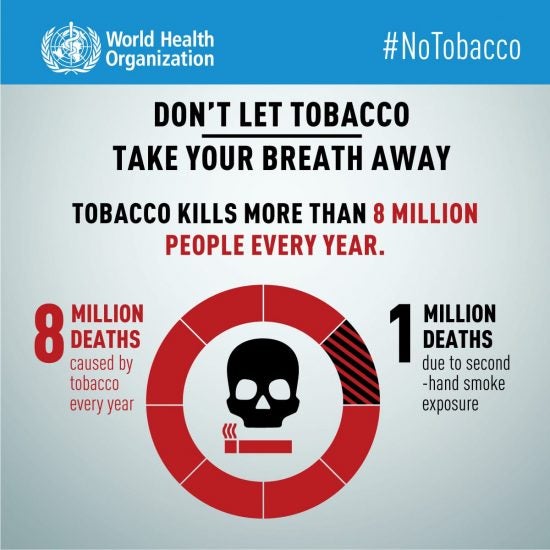Every May 31, since 1987, the World Health Organization (WHO) sponsors the World No Tobacco Day, an annual awareness day intended to highlight the health risks associated with tobacco use and encourage governments to adopt effective policies to reduce smoking and the use of other tobacco products.
According to WHO, tobacco use kills more than 7 million people around the world each year, and that number is predicted to grow unless anti-tobacco actions are increased. In the United States, tobacco use is the largest preventable cause of death and disease. It causes many types of cancer, as well as heart disease, stroke, lung disease, and other health problems.
The focus of this year’s World No Tobacco Day is on “tobacco and lung health.” There are multiple ways in which exposure to tobacco affects the health of people’s lungs worldwide. These include:
 Lung cancer. Tobacco smoking is the primary cause for lung cancer, responsible for over two thirds of lung cancer deaths globally. Second-hand smoke exposure at home or in the work place also increases risk of lung cancer. Quitting smoking can reduce the risk of lung cancer: after 10 years of quitting smoking, risk of lung cancer falls to about half that of a smoker.
Lung cancer. Tobacco smoking is the primary cause for lung cancer, responsible for over two thirds of lung cancer deaths globally. Second-hand smoke exposure at home or in the work place also increases risk of lung cancer. Quitting smoking can reduce the risk of lung cancer: after 10 years of quitting smoking, risk of lung cancer falls to about half that of a smoker.
Chronic respiratory disease. Tobacco smoking is the leading cause of chronic obstructive pulmonary disease (COPD), a condition where the build-up of pus-filled mucus in the lungs results in a painful cough and agonising breathing difficulties. The risk of developing COPD is particularly high among individuals who start smoking at a young age, as tobacco smoke significantly slows lung development. Tobacco also exacerbates asthma, which restricts activity and contributes to disability. Early smoking cessation is the most effective treatment for slowing the progression of COPD and improving asthma symptoms.
Across the life-course. Infants exposed in-utero to tobacco smoke toxins, through maternal smoking or maternal exposure to second-hand smoke, frequently experience reduced lung growth and function. Young children exposed to second-hand smoke are at risk of the onset and exacerbation of asthma, pneumonia and bronchitis, and frequent lower respiratory infections.
Globally, an estimated 165 000 children die before the age of 5 of lower respiratory infections caused by second-hand smoke. Those who live on into adulthood continue to suffer the health consequences of second-hand smoke exposure, as frequent lower respiratory infections in early childhood significantly increase risk of developing COPD in adulthood.
Tuberculosis. Tuberculosis (TB) damages the lungs and reduces lung function, which is further exacerbated by tobacco smoking. About one quarter of the world’s population has latent TB, placing them at risk of developing the active disease. People who smoke are twice as likely to fall ill with TB. Active TB, compounded by the damaging lung health effects of tobacco smoking, substantially increases risk of disability and death from respiratory failure.
Air pollution. Tobacco smoke is a very dangerous form of indoor air pollution: it contains over 7 000 chemicals, 69 of which are known to cause cancer. Though smoke may be invisible and odourless, it can linger in the air for up to five hours, putting those exposed at risk of lung cancer, chronic respiratory diseases, and reduced lung function.
Lung health is not achieved merely through the absence of disease, and tobacco smoke has major implications for the lung health of smokers and non-smokers globally.
In order to achieve the Sustainable Development Goal (SDG) target of a one-third reduction in NCD premature mortality by 2030, tobacco control must be a priority for governments and communities worldwide. Currently, the world is not on track to meeting this target.



